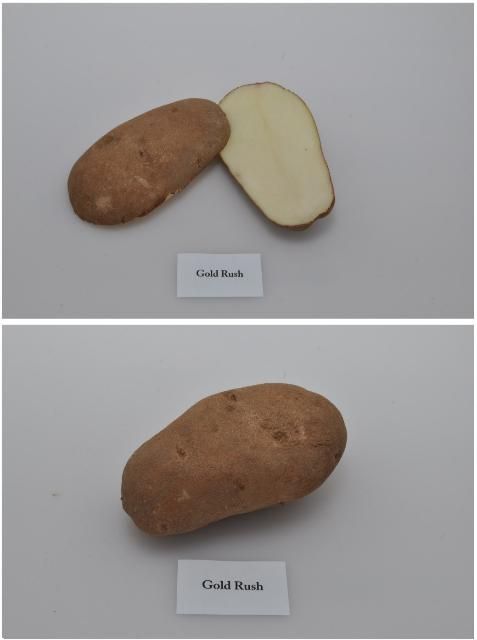There are several potato varieties available in the market today. Most of them have been bred or developed in production regions other than Florida. The University of Florida Potato Variety Evaluation Program screens new germplasm from public and private breeding programs and identifies the most promising cultivars for commercial potential considering broad adaptability to Florida climate and conditions and market purpose: processing, fresh-market and specialty-type varieties. Over the years, the UF/IFAS Potato Variety Program has become an important reference to vegetable growers, seed producers, processors, crop insurance agencies, and brokers looking for alternative potato varieties to explore different markets, improved characteristics, and yield. This UF/Potato Variety Trials Spotlight presents a summary of the field evaluation of tuber yield and quality performance of the potato variety 'French Fingerling' cultivated in Florida.
General Comments
'French Fingerling' is a fresh potato variety that is commonly grown for the specialty potato market. It was formerly known as 'Roseval'. The cultivar was selected from a progeny of a cross between 'Vale' and 'Rosa'. It was released in 1950 by SICA Bretagne Plants, a member of the National Federation of Producers of Potato Plants in France. 'French Fingerling' demonstrated adaptability to Florida growing conditions by producing high yield and good tuber characteristics. Tuber production and quality results provided in this spotlight are from the Florida Potato Variety Trials conducted at the UF/IFAS Hastings Agricultural Extension Center between 2010 and 2018.
General Characteristics
'French Fingerling' plants exhibit a semi-erect growth characteristic with moderate to good foliage cover. Tubers have a pink and smooth skin with light-yellow flesh (Figure 1), according to Florida's rating codes for potato tuber characteristics (Table 1). The tubers are oblong to long-shaped with rounded edges and intermediate to shallow eye depth. The variety has medium to long dormancy (time required for sprout emergence). In Florida trials, 'French Fingerling' yield ranged from 100 to 199 cwt/acre with an average specific gravity of 1.056 (Tables 2 and 3). On average, 87% of the tubers exhibited a tuber size distribution between 0.5 and 1? inches (within size classes C and B, Table 2), confirming the culinary functionality of this potato variety.

Credit: Lincoln Zotarelli, UF/IFAS
Diseases
'French Fingerling' exhibited no incidence of corky ring spot, hollow heart, or brown spot. The cultivar had a 6% incidence of internal heat necrosis under Florida conditions (Table 3). The standard UF/IFAS Extension recommended disease and weed control program described under Potato Production (Chapter 14 of the Vegetable Production Handbook for Florida, https://edis.ifas.ufl.edu/cv131) should be followed.
Season Length and Growth
'French Fingerling' is a medium- to late-maturing variety under Florida growing conditions. Season length was 93 days on average from planting to harvest. This depended on weather conditions during the growing season. The plants should be harvested two weeks after vine kill to improve tuber maturation and skin set. Potatoes with proper skin set maintain better skin color, lose less weight in storage, and are more resistant to bruising and soft rot. For more information about vine killing on potatoes, see Potato Vine Killing or Desiccation (Zotarelli et al. 2016). Late in the season, tuber size should be checked regularly to harvest tubers with desirable marketable size. Soil moisture should be managed late in the season to avoid high soil moisture conditions that cause enlarged lenticels and delayed skin set.
Fertilization
UF/IFAS trial plots are normally fertilized with 200 to 230 lb/ac of N. The first application of 100 lb/A of N (granular) is typically incorporated in the bed prior to planting, followed by one or two side-dress fertilizer applications at emergence and/or at tuber initiation. Phosphorus and potassium applications follow the UF/IFAS guidelines described in Liu et al. (2020) and normally range between 45 to 100 lb/ac of P2O5 and 170 to 235 lb/ac of K2O.
Planting
A seed piece of 2.5 to 3 oz is recommended for planting. Crop should be planted with 40 inches between rows and 8 inches between plants, at 3 to 4 inches deep. A seed rate of 2,000 to 3,000 lb/acre of seed is expected.
Other Information
For additional information on cultivation and weed and disease management, see the Potato Production chapter of the Vegetable Production Handbook, available at https://edis.ifas.ufl.edu/cv131.
References
Hutchinson, C. M., J. M. White, D. M., Gergela, P. A. Solano, K. G. Haynes, R. Wenrich, and C. S. Lippi. 2003. "Performance of chip processing potato varieties in northeastern Florida." HortTechnology 13 (4): 706–711. https://doi.org/10.21273/HORTTECH.13.4.0706
Liu, G., E. H. Simonne, K. T. Morgan, G. J. Hochmuth, S. Agehara, and R. Mylavarapu. 2020. Chapter 2. Fertilizer Management for Vegetable Production in Florida. Vegetable Production Handbook for Florida, 2020–2021 Edition. CV296. Gainesville: University of Florida Institute of Food and Agricultural Sciences. https://edis.ifas.ufl.edu/cv296
Roseval. 2005. The European Cultivated Potato Database. https://www.europotato.org/varieties/view/Roseval-E. Accessed 23 April 2020
Sisson, J. A., and G. A. Porter. 2002. "Performance evaluations of potato clones and varieties in the northeastern states—1999." Maine Agr. For. Expt. Sta., Misc. Publ. 751.
Specialty Produce. n.d. "'French Fingerling' Potatoes." https://www.specialtyproduce.com/produce/French_Fingerling_Potatoes_477.php. Accessed 24 April 2020..
Zotarelli, L., P. J. Dittmar, P. D. Roberts, J. Desaeger, and B. Wells. 2020. Chapter 14. Potato Production. Vegetable Production Handbook for Florida 2020–2021 Edition. HS733. Gainesville: University of Florida Institute of Food and Agricultural Sciences. https://edis.ifas.ufl.edu/cv131
Zotarelli, L., S. Sargent, P. Dittmar, and M. Makani. 2016. Potato Vine Killing or Desiccation. HS181. Gainesville: University of Florida Institute of Food and Agricultural Sciences. https://edis.ifas.ufl.edu/hs181
Summary of production statistics and specific gravity of 'French Fingerling' potato variety grown at the UF/IFAS Hastings Agricultural Extension Center, Hastings, FL from 2012 to 2018.